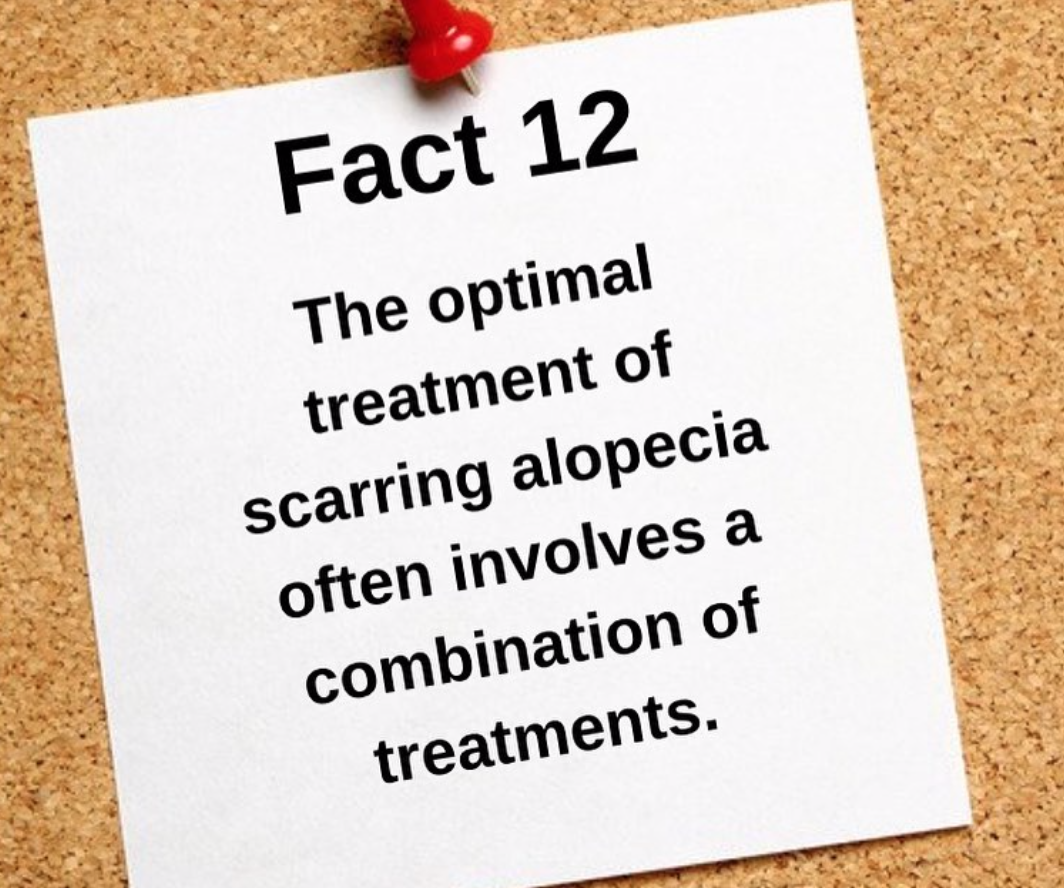National Scarring Alopecia Awareness Month (Day 12, Fact 12): Treatment for Scarring Alopecia May Involve A Combination of Treatments
The Optimal Treatment Plan for Scarring Alopecia often Involves a Combination of Treatments
Many patients with scarring alopecia use a combination of treatments. Some use 2 or three and some use 5 or 6 or 7
Example 1: Combination Treatments in Lichen Planopilaris
Consider a 43 year old male patient with lichen planopilaris. He uses topical clobetasol lotion three times weekly and a compounded tacrolimus lotion 3 times weekly. He uses clobetasol shampoo once weekly. He is using hydroxychloroquine with good effect and now also uses cetirizine 20 mg daily. Steroid injections are administered every 3 months to any actove areas.
Example 2: Combination Treatments in Frontal Fibrosing Alopecia
Consider a 52 year old female patient with frontal fibrosing alopecia. She uses dutasteride five times weekly with isotretinoin 10 mg daily. Pimecrolimus is applied to the hairline 3 times weekly and fluocinonide gel is used 2 times per week. Steroid injections are administered every 3 months. Rogaine foam is also used in the hairline. Eyebrows are treated with minoxidil foam and pimecrolimus cream and periodic steroid injections. The eyelashes are supported by use of topical bimatoprost (Latisse).
Example 3: Combination Treatments in Folliculitis Decalvans
The 27 year old male with folliculitis decalvans uses doxycycline 100 mg daily with steroid injections every 3 months. An antibacterial shampoo is used alongside an antidandruff shampoo. 2 % clindamycin is compounded into betamethasone lotion to use when bumps on the scalp get bad. Oral minoxidil is used to support growth of the androgenetic alopecia that is present after topical minoxidil was found to be too irritating.
Treatment Duration Ranges from 6 months to Decades
I am often asked how long treatment is given. I tell patients that depends if the treatment is actually working. Contrary to what many believe, not all treatments help all patients. So if a treatment is not helping control inflammation or symptoms or shedding or stop progression of hair loss, we stop it. That’s where the expertise and experience of the physician come into the picture.
If a treatment is helping it is continued anywhere from 6 months to many decades. Generally speaking it is quite an extended period although the perception many have is that treatments are just needed short term. This is often not the case. I tell patients that the average person’s immune system has had 3-10 years to prepare the attack against the hair follicles and so one can not expect the battle won against the very clever immune system in a matter of days or weeks.
Stopping Treatments Once the Disease Becomes Quiet.
Once a patient’s scarring alopecia has shown that it has become quiet, I continue treatments a bit longer (6 months) before starting to remove or reduce a treatment. Most treatments are tapered if possible. No treatment is stopped suddenly or “cold turkey” if possible. Some like dutasteride for FFA are probably best continued forever given that it treats androgenetic alopecia that is probably present as well. The treatment of androgenetic alopecia is forever.
If you’ve ever hear a crowd erupt in cheering, and applause after a rock band, symphony or opera comes to an end you can imagine the same potential reactivation of the immune system when treatments are stopped suddenly. Stopping suddenly is rarely good.
Treatments are tapered one a time usually starting with the systemic treatment. If we stop 5 treatments at once and the patient has a flare one will have no idea which one was responsible for the problem when stopped. This is my view but treatments are stopped in a logical and delicate manner.
Slight Improvement in Hair Density is Possible when Scarring Alopecia is Addressed Very Early in the Course of Disease.
Some degree of regrowth can occur if the disease is caught early enough. The emphasis is on early enough. It is not usually complete hair regrowth but there can be some improvement. Discoid lupus, dissecting cellulitis, and frontal fibrosing alopecia and central centrifugal cicatricial alopecia are most well known for giving some improvement in hair density if the disease is caught “very early” in its evolution and provided reasonably aggressive treatment is used. Lichen planopilaris and folliculitis decalvans may improve a bit if caught early as well.
For most patients the goal of treatment is stop the disease rather than getting back hair. If a patient looks the same in 12 months as they do today, we probably have a treatment success. If the patient looks the same in 12 years as they do today we definitely have a treatment success.
This article was written by Dr. Jeff Donovan, a Canadian and US board certified dermatologist specializing exclusively in hair loss.

